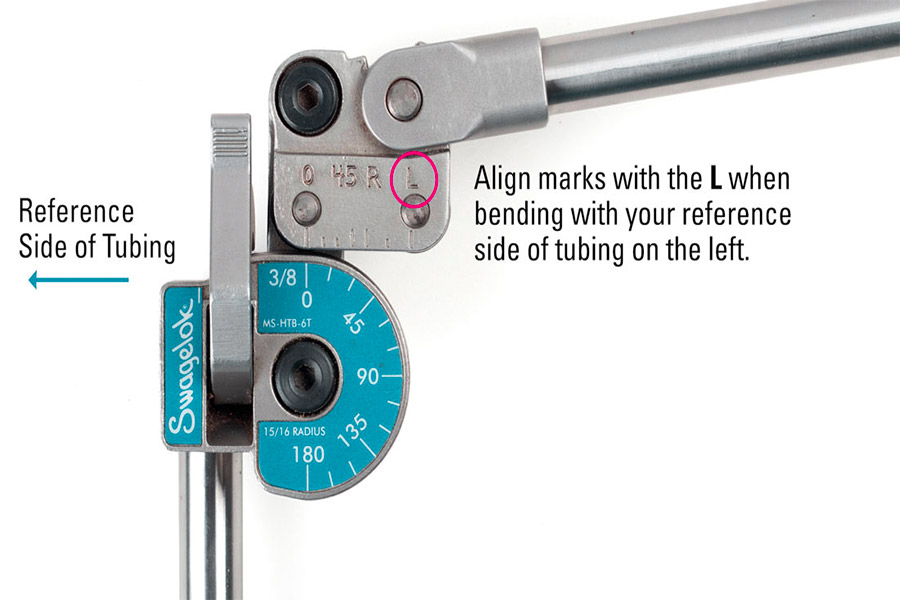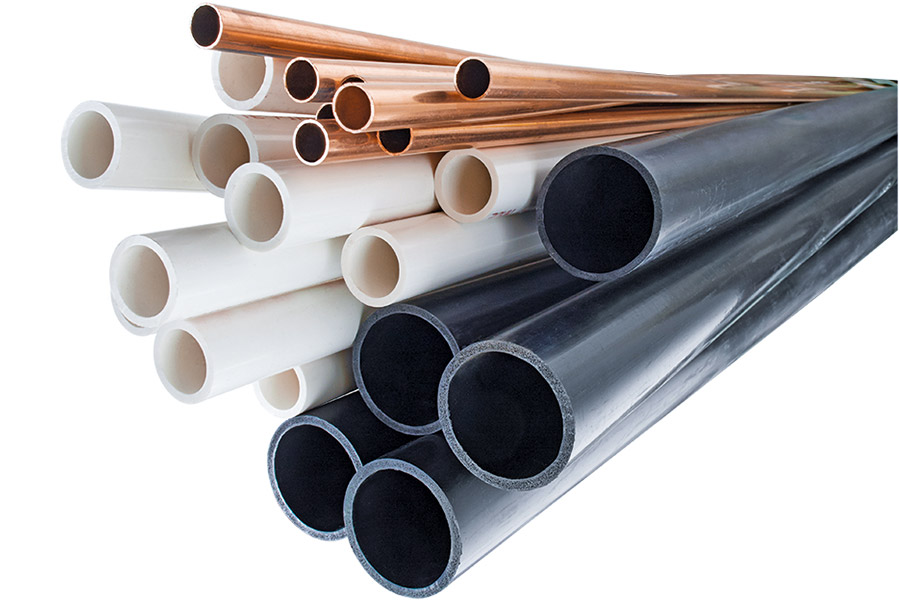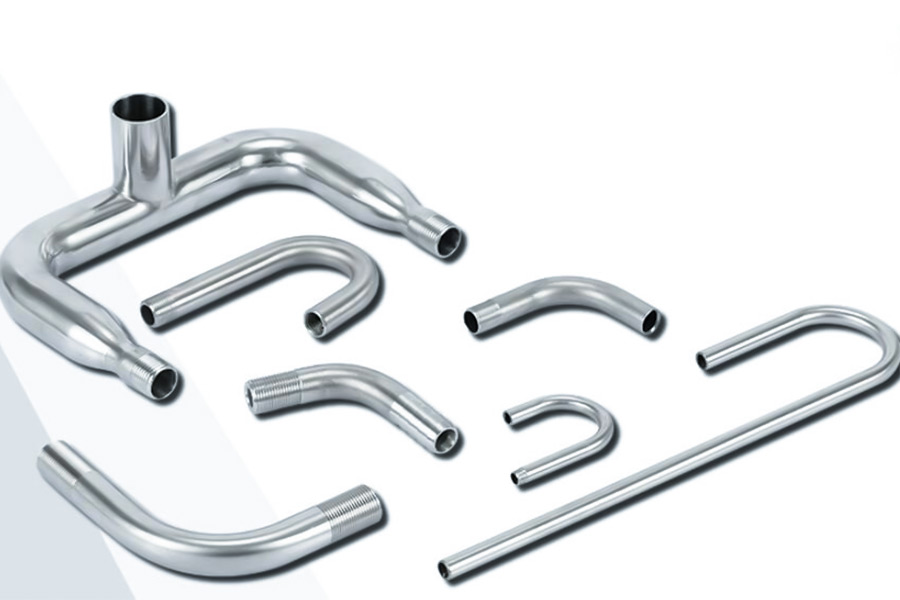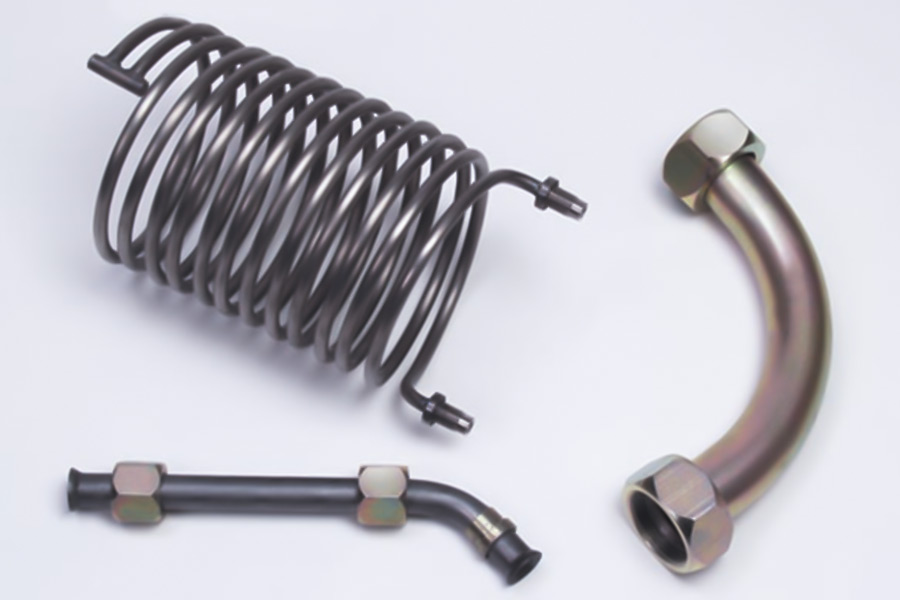In the fields of pipe installation, car modification, furniture manufacturing, industrial equipment production, etc., pipe bending is extremely critical and technically demanding. Proper pipe bending is critical to ensuring the tightness, strength and longevity of the piping system. Next, we will introduce you in detail how to bend pipes, including bending techniques for different materials, tool selection, and solutions to common problems to help you get the job done efficiently.
How to Bend Tube and Pipe?
When processing pipes, the bending method depends on the type of pipe and the actual needs. Common bending methods are as follows:
1. Manual pipe bending method (suitable for small-diameter pipes)
- Scope of application: It is mostly used for copper pipes, aluminum pipes and thin-walled steel pipes with a diameter of ≤ 25mm, because of its soft texture, which is easy to operate manually.
- Tools required: manual pipe bender, spring pipe bender assistant.
- Operation steps: Put the pipe into the pipe bender card slot to align the starting position, rotate the handle at a constant speed to prevent the deformation of the pipe wall, check the angle at any time, and stop when the standard is reached.
- Advantages and disadvantages: low cost, simple operation, suitable for small amount of processing; However, it is not able to cope with large-diameter or thick-walled pipes, which is easy to cause poor bending.
2. Hot bending method (suitable for thick-walled metal pipes)
- Scope of application: Mainly for steel pipes, stainless steel pipes and other metal pipes with large wall thickness, which are easy to crack or deform by cold bending.
- Tools required: oxyacetylene welding gun, pipe bending mold, thermometer.
- Operation steps: Use a welding torch to heat the bending part of the pipe until it is dark red (about 700°C), quickly move it to the mold for bending and forming, and cool it naturally, avoid water cooling.
- Advantages and disadvantages: It can solve the problem of thick-walled pipe bending, and the molding is regular; However, the temperature and heating range need to be strictly controlled, and the flame operation is risky, so professional equipment and experience are required.
3. Hydraulic / CNC pipe bender (industrial mass production)
- Scope of application: It can process all kinds of metal pipes, especially suitable for high-precision bending of large-diameter and thick-walled pipes.
- Required equipment: hydraulic pipe bender, CNC pipe bender.
- Operation steps: input the pipe parameters in the equipment system, start the automatic bending of the equipment after fixing the pipe, measure the actual angle and adjust the parameters according to the rebound compensation.
- Advantages and disadvantages: high bending accuracy, fast efficiency, suitable for mass production; However, the equipment is expensive, and the operators need professional training.
4. Plastic pipe bending method (PVC/PPR and other common plastic pipes)
- Scope of application: like PVC pipes, PE pipes, PPR pipes, etc., which are commonly used in building water supply and drainage, electrical conduits.
Common methods and steps: - Hot air gun heating method: use a hot air gun to heat the bend of the pipe to about 150°C, bend it to the desired angle after softening, and cool and set.
- Silica sand filling method: first fill the dry fine sand and seal the nozzle, heat and bend and pour out the sand to prevent the inner wall from collapsing.
- Advantages and disadvantages: simple operation, suitable for home or small projects; However, the heating temperature and time should be strictly controlled to prevent the pipe from melting and deforming.

Why do you need to bend pipes?
In many engineering projects, using straight pipes directly cannot meet complex installation requirements, such as:
1. Save space and optimize the layout
In many construction scenarios, space is limited, and it is difficult for straight pipes to meet the needs of complex paths. Elbows can bypass beams, cables, and other pipes, reducing joints to reduce the risk of leakage, and fit into tight spaces such as car chassis and building mezzanine. For example, water pipes in narrow ceilings or walls in buildings can be bent to reduce unnecessary joints; The exhaust pipe of the car is bent to avoid the chassis mechanical structure.
2. Improve the efficiency of fluid/gas transportation
Straight pipes connected to right-angle joints can cause a lot of fluid resistance and pressure loss. Smooth bends can reduce turbulence, make fluid flow smoother, reduce energy consumption of HVAC systems, hydraulic lines, etc., reduce fluid impact and wear on pipes, and extend pipe life. For example, the use of large-radius elbows in chemical pipelines can effectively reduce fluid resistance and prevent material deposition; The curved tubing of the hydraulic system optimizes pressure transfer and reduces energy consumption.
3. Enhance structural strength and durability
Compared with multiple welded joints, the whole elbow has higher mechanical strength, no welding weak points, and good seismic resistance, which is suitable for automotive, aviation and other fields, and can reduce the risk of corrosion and leakage. For example, bent steel pipes for bicycle and motorcycle frames can make the stress distribution more reasonable; Industrial equipment frames reduce weld joints and improve overall stability.
4. Improve aesthetics and design flexibility
In decoration engineering and product design, elbows can create a streamlined appearance to meet the design needs of furniture, lamps, railings, etc., and can be customized with unique shapes to achieve seamless connections and avoid seams affecting aesthetics. For example, modern furniture uses bent metal pipes to make simple tables and chairs; In architectural decoration, curved stainless steel pipes are used to create stair handrails and display shelves.
5. Reduce costs and improve installation efficiency
Although bending requires specialized tools, in the long run, it can reduce the amount of pipe used, save on joint and flange costs, and reduce the number of welded and threaded connection steps during installation, which takes less time. And the whole elbow is more reliable than the pipe connected by multiple joints, and the maintenance is more worry-free. The comparison shows that the cost of straight pipe and joint is high, the installation is slow, and the maintenance is frequent, while the elbow pipe has low material cost, fast installation and easy maintenance.

Economic comparison:
| Solution | Straight pipe + joint | Bent pipe |
|---|---|---|
| Material cost | High (multiple accessories) | Low (one-piece molding) |
| Installation time | Long (welding/tightening required) | Short (direct laying) |
| Maintenance frequency | High (joints are prone to leakage) | Low (strong integrity) |
How to choose the material of pipe bending mold?
In pipe bending, the choice of mold material directly affects production efficiency, pipe forming quality and mold life. Whether it is manual pipe bending or CNC pipe bending machine, choosing the wrong material may cause rapid wear of the mold, scratches on the pipe surface and even forming failure. Below we will explain in detail how to scientifically select pipe bending mold materials from three dimensions: material performance, processing scenario, and cost-effectiveness.
1. Core performance requirements of pipe bending molds
(1) Wear resistance
The mold needs to withstand high-frequency friction with the pipe, especially when processing high-hardness pipes such as stainless steel and titanium alloys, the surface hardness of the material must be ≥HRC 55.
(2)Impact resistance
During the pipe bending process, the mold may be subjected to instantaneous high pressure (such as the pressure of the hydraulic pipe bending machine can reach 200MPa), and the material must have good toughness to prevent cracking.
(3)Anti-adhesion
To avoid adhesion between the pipe and the mold (such as aluminum tubes are easy to stick to the mold), it is necessary to select materials with smooth surfaces or special treatments.
(4)Thermal stability
In the hot bending process (such as bending steel pipes heated to 700°C), the mold material must be resistant to high temperatures and maintain strength.
2. Comparative analysis of common pipe bending mold materials
| Material type | Applicable scenarios | Advantages | Disadvantages | Cost |
|---|---|---|---|---|
| Tool steel (Cr12MoV) | Cold bending of small and medium-sized batches of metal pipes (copper, aluminum, low carbon steel) | High hardness (HRC 58-62), easy to process | Easy to soften at high temperatures, not corrosion-resistant | Medium |
| Alloy steel (H13) | Hot bending process (stainless steel pipes, thick-walled steel pipes) | High temperature resistance (maintain hardness at 500°C) | Surface nitriding treatment is required, and the cost is relatively high | High |
| Polyurethane (PU) | Thin-walled pipe/plastic pipe anti-scratch bending (PVC, copper pipe) | Elastic buffer, protect the surface of the pipe | Short life (about 5000 bends) | Low |
| Cast iron (QT600-3) | Large pipe bending machine mold (DN ≥ 100mm) | High compressive strength, good shock absorption | High brittleness, easy to collapse | Low |
| Carbide (YG8) | High-precision CNC pipe bending (aerospace titanium alloy pipe) | Ultra-high hardness (HRA 89), life span over 100,000 times | Difficult to process, expensive | Very high |
3. Key factors and matching solutions for selection
(1) Select according to the type of pipe
- Soft metal pipe (copper, aluminum): tool steel or polyurethane (avoid scratching the surface)
- Stainless steel/titanium alloy pipe: carbide or H13 steel with titanium coating on the surface
- Plastic pipe (PVC/PE): polyurethane mold + silicone protective cover

(2) Select according to the processing technology
- Cold bending process: Cr12MoV tool steel (best cost performance)
- Hot bending process: H13 hot working die steel (high temperature resistance and fatigue resistance)
- High-speed CNC bending: carbide (high precision and long life)
(3)Select according to production batch
| Production scale | Recommended materials | Expected life |
|---|---|---|
| Small batch/DIY (<1000 pieces) | Polyurethane or cast iron mold | 500-3000 times |
| Medium batch (10,000-50,000 pieces) | Tool steel (Cr12MoV) | 30,000-50,000 times |
| Large batch (>100,000 pieces) | Cemented carbide (YG8) | More than 100,000 times |
Can manual pipe bending achieve ±0.5° accuracy?
Manual bending may theoretically approach ± 0.5° accuracy under ideal conditions, but it is extremely difficult to achieve stably in practical applications for the following reasons:
1. Constraints
- Springback effect: there must be springback after the metal pipe is bent (usually the rebound angle is 1°~5°), and it is necessary to rely on experience to predict the amount of bending, but it is difficult to accurately control manual adjustment.
- Operation error: uneven manual force, pipe bend clearance tolerance (±0.2~1°), etc. will lead to deviation.
- Limitation of measuring tools: The accuracy of ordinary angle ruler is ±1°, and the high-precision digital angle meter (±0.1°) needs to be strictly calibrated and complicated to operate.
2. Implementation conditions (harsh)
- Special tool: Use a manual tube bender with angle compensation (e.g. RIDGID 404) in combination with a digital angle sensor.
- Material consistency: The wall thickness and hardness of the pipe need to be highly uniform (such as aviation-grade aluminum alloy pipe).
- Operator skills: It takes long-term training, and it takes 5~10 minutes for a single adjustment, which is extremely inefficient.
3. Alternatives
- To achieve a stable accuracy of ±0.5°, it is recommended that:
- Hydraulic pipe bender servo control system (accuracy±0.3°)
- CNC pipe bender (accuracy±0.1°, programming and debugging required)
Manual pipe bending is only suitable for situations where the accuracy requirement is ≤±1°, and ±0.5° needs to rely on semi-automatic/fully automatic equipment to achieve.
Why is the temperature control of the hydraulic pipe bender critical?
In the field of metal pipe processing, hydraulic pipe bending machine is one of the core equipment, and temperature control is often the key factor that determines the processing quality and equipment life.
1. Direct relationship between hydraulic oil performance and temperature
- Optimal operating temperature range: 40-60℃
- Low temperature problem (<15℃):
- Oil viscosity increases by more than 30%
- System pressure loss increases significantly
- Motor starting load increases by 50%
- High temperature problem (>65℃):
- Oil viscosity decreases by 50%
- Internal leakage increases by 20-30%
- Oxidation speed increases (lifespan is halved for every 10℃ rise in temperature)
- Solution: Install intelligent temperature control system to adjust heating/cooling device in real time
2. Temperature dependence of sealing system reliability
| Temperature range | Seal status | Potential risks |
|---|---|---|
| <0℃ | Hardening, embrittlement | Risk of explosion during installation (+80%) |
| 15-60℃ | Optimal elasticity | Normal service life (about 5 years) |
| >80℃ | Softening, expansion | Probability of seal failure increased by 300% |
Industry data: More than 65% of hydraulic leakage accidents are related to seal aging caused by temperature runaway
3. Temperature sensitivity of machining accuracy
The influence mechanism of temperature on bending accuracy
Oil viscosity changes → System pressure fluctuation ±5%
Metal thermal expansion and contraction → Die gap changes 0.02-0.05mm
Servo valve response delay → Control accuracy decreases by 30%
Measured data:
For every 10°C above the standard range of oil temperature, the angle deviation increases by 0.3-0.5°
When the temperature difference is >15°C during continuous operation, the tolerance of batch products will exceed the limit
4. Temperature limit protection for key components
The maximum temperature tolerance of each component
- Hydraulic pump: 70℃ (exceeding the alarm will trigger)
- Solenoid valve: 65℃ (high temperature will cause easy jamming)
- High-pressure hose: 90℃ (long-term >80℃ will accelerate aging)
Maintenance recommendations:
- Check the oil acid value (TAN) every 500 hours
- Use infrared thermal imager to scan hot spots regularly
5. Comparison of intelligent temperature control solutions
| Control method | Accuracy | Response speed | Applicable scenarios |
|---|---|---|---|
| Air cooling | ±5℃ | Slow (30min) | Small machines, intermittent operation |
| Water cooling | ±3℃ | Medium (10min) | Medium-sized machines, constant temperature workshops |
| Semiconductor cooling | ±1℃ | Fast (1min) | Precision CNC pipe bending machine |
| Instant Aerospace-grade processing | ±0.5℃ | Instant | Aerospace-grade processing |
How to calculate the minimum bend radius?
1. Basic calculation formula
Minimum Bending Radius (Rmin) = Material Elongation Factor (α) × Tube Outer Diameter (D)
Common Material Coefficients Reference:
| Material type | α value range | Typical application scenarios |
|---|---|---|
| Low carbon steel | 2-3 | Structural steel pipe |
| Stainless steel 304 | 3-4 | Food machinery pipeline |
| Aluminum alloy 6061-T6 | 4-5 | Automobile exhaust system |
| Copper pipe | 1.5-2 | Refrigeration pipeline |
2. Wall thickness correction formula
When the wall thickness (t) is > D/20:
Rmin Correction = Base Rmin × (1 0.1×(t/D))
3. Practical application cases
Φ50×2mm stainless steel pipe bending:
Rmin=3×50=150mm → 180mm mold is actually used
What are the special requirements for car exhaust pipe bending?
Special requirements for automobile exhaust pipe bending mainly include:
| Requirement category | Specific specifications | Industry standards |
|---|---|---|
| Material | 409/304 stainless steel (resistant to 800℃ high temperature) | SAE J2530 |
| Roundness | Section ovality after bending ≤5% | ISO 9001 |
| Surface treatment | Internal polishing (reduce carbon deposits) | EPA emission regulations |
| Connection method | Flange interface ±0.2mm parallelism tolerance | Car OEM standard |
Special process:
Mandrel bending is required to prevent wrinkles
Argon protection is required after welding to prevent oxidation
How to bend thick wall pipe using flame heating?
1. Equipment preparation list
| Tool name | Specifications | Notes |
|---|---|---|
| Oxyacetylene torch | Medium welding gun (No. 1-2) | Adjust neutral flame |
| Temperature measuring instrument | Infrared temperature measurement (0-1200℃) | Regular calibration |
| Bending mold | Radius R ≥ 3D | Pre-coat high temperature anti-sticking agent |
2. Step-by-step operation process
- Preheating treatment: 600-650℃ uniform heating (carbon steel)
Heating control:
- Moving speed: 50-100mm/min
- Heating bandwidth: 3 times wall thickness
Bending skills:
- Tempering once every 15° bend
- Final bending temperature>500℃ (anti-quenching)
3. Quality acceptance standards
Heating zone grain size ≤ Grade 5
Oxide layer thickness<0.1mm
Bending angle error<±1°
Why is it necessary to relieve stress after bending the pipe?
The main reasons why the pipe must be stress relieved after bending are:
Prevent deformation and cracking:
- Residual stress causes deformation in later machining (error +0.3mm/m)
- The risk of stress corrosion cracking increases by 50%
Restore material properties:
- The hardness of the cold work hardening area increases by 20%, but the toughness decreases by 40%
Industry specification requirements:
- ASME B31.3 stipulates: Annealing is required for wall thickness deformation rate > 5%
Stress relief method:
- Heat treatment: 600-650℃ insulation for 1 hour (carbon steel)
- Vibration aging: Applicable to large pipe fittings (cost reduction of 70%)

How to quickly detect the quality of pipe bending?
Three-step method for quick inspection of bending quality
1. Appearance inspection
- Use a 10x magnifying glass to check for surface cracks
- Evaluation of oxidation color uniformity (reference standard color card)
2. Dimension inspection tool kit
| Test items | Recommended tools | Accuracy requirements |
|---|---|---|
| Bending angle | Digital angle ruler | ±0.1° |
| Ovality | Coordinate measuring machine | 0.01mm |
| Wall thickness reduction rate | Ultrasonic thickness gauge | ±0.05mm |
3. Performance test
- Air pressure test: 1.5 times the working pressure for 5 minutes
- Metallographic inspection: Cut the sample to observe the grain morphology
What are the cost tips for household DIY elbows?
Comparison of low-cost solutions:
| Requirements | Professional tools | DIY alternatives | Cost comparison |
|---|---|---|---|
| Small diameter metal pipes | Manual pipe bender (¥300) | Sand filling + gas stove heating + wooden board mold | ¥30 |
| PVC pipe shaping | Spring pipe bender (¥50) | Hair dryer heating + hollow brick positioning | ¥0 (use of old items) |
| Angle measurement | Digital display angle meter (¥200) | Mobile APP (such as Angle Meter) | Free |
Key tips:
Aluminum tubes/copper tubes can be frozen to increase hardness (freeze at -18℃ for 2 hours)
Use PVC tubes instead of metal tubes (cost reduction of 90%)
Summary
The key to mastering how to bend a tube is to choose the right tools, control the bending speed, and use the appropriate methods for different materials. For DIY enthusiasts, manual tube benders and heat guns are economical and practical options; while industrial applications require more sophisticated CNC tube bending technology.
If you have more questions about bending tubes, please feel free to share in the comments section!
📞 Phone: +86 185 6675 9667
📧 Email: info@longshengmfg.com
🌐 Website: https://lsrpf.com/
Disclaimer
The content of this page is for informational purposes only.LS SeriesNo representations or warranties of any kind, express or implied, are made as to the accuracy,completeness or validity of the information. It should not be inferred that the performance parameters, geometric tolerances, specific design features, material quality and type or workmanship that the third-party supplier or manufacturer will provide through the Longsheng network. This is the responsibility of the buyerAsk for a quote for partsto determine the specific requirements for these parts.please Contact us Learn more information.
LS Team
LS is an industry-leading companyFocus on custom manufacturing solutions. With over 20 years of experience serving more than 5,000 customers, we focus on high precisionCNC machining,Sheet metal fabrication,3D printing,Injection molding,metal stamping,and other one-stop manufacturing services.
Our factory is equipped with more than 100 state-of-the-art 5-axis machining centers and is ISO 9001:2015 certified. We provide fast,efficient and high-quality manufacturing solutions to customers in more than 150 countries around the world. Whether it's low-volume production or mass customization,we can meet your needs with the fastest delivery within 24 hours. chooseLS TechnologyIt means choosing efficiency, quality and professionalism.
To learn more, please visit our website:www.lsrpf.com

FAQs
1.How do I bend a pipe without a bender?
In the absence of professional equipment, the filling hot bending method can be used: select a cylindrical mold (such as an iron pile or a wooden pile) that matches the pipe diameter, fill the pipe lumen with dry fine sand and seal the port (to prevent deformation), heat the bending part evenly with an oxyacetylene flame until it is dark red (about 600-800 °C), and quickly bend it slowly with a lever. For thin-walled pipes (wall thickness ≤ 2mm), cold bending can be used instead - using a self-made lever bender (consisting of a channel, a shaft and a handle), which is gradually formed by multiple bends in sections (5-10° each), and after bending, it needs to be annealed to relieve stress. This method can complete the bending of R≥3D, and the accuracy error is controlled within ±2°.
2.What is the cheapest method of bending?
The lowest cost is the manual spring pipe bending method, which only needs to purchase a spring pipe bender (average price of ¥15-30) or use existing resources: a high-strength spring (wire diameter 3-5mm) is threaded into the tube, one end is fixed with a vise at a predetermined bending point, and the other end is manually bent by lever principle. It is suitable for soft materials such as copper pipes and aluminum pipes with an outer diameter of ≤ 25mm, with a bending radius of up to 2D, and can be used with wooden molds (self-made cost≈ ¥0) to improve accuracy. If carbon steel pipes are processed, they can be combined with hot bending, which is locally heated to orange red (about 900°C) with a blowtorch and then bent by hand, and the cost of a single processing is less than ¥1.
3.Which bending method is the easiest?
The cold-pressed pipe bending method is the easiest to operate: use an adjustable manual pipe bender (such as JD-25 type, ¥150-300), adjust the mold to the target radius, insert the pipe into the clamping device and directly pull the handle to complete the 90° bending, without heating or filling, a single person can complete the bending of Φ12-25mm metal pipe in 3 minutes, and the ovality is controlled within 8%. For plastic pipes such as PVC, it is easier to bend around the cylindrical mold after heating and softening with a heat gun (¥80-150), and the heating temperature is set at 120-160°C, and the heating temperature is kept at a constant speed to rotate and heat, and it can be freely shaped in 30 seconds.
4.What are the main types of tube bending methods?
The mainstream tube bending process is divided into two categories: cold bending (room temperature processing) including rolling bending (accuracy ± 0.5°), compression bending (efficiency 30 pieces/hour) and winding (R≥1.5D), suitable for medium and thin wall pipes, and hot bending method improves plasticity through local heating (flame/induction), suitable for thick-walled (t/D>1/10) or high hardness materials. According to the equipment, it can be divided into manual mechanical type (error ± 2°), hydraulic numerical control type (accuracy ± 0.1°) and servo-electric type (speed 0.5-5s/time). Special processes such as laser bending (micron precision) are used in the manufacture of precision medical devices.







